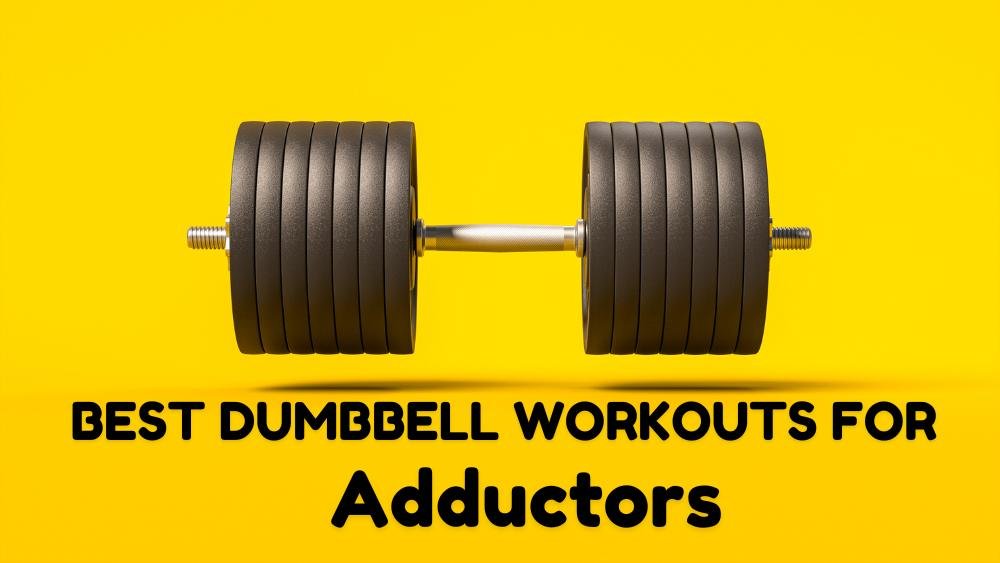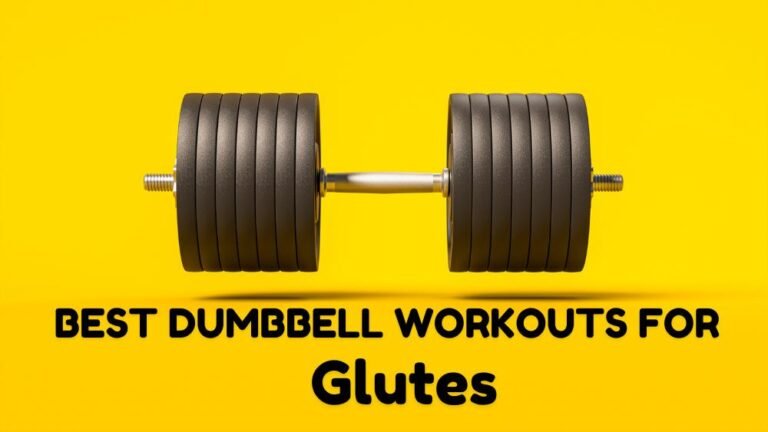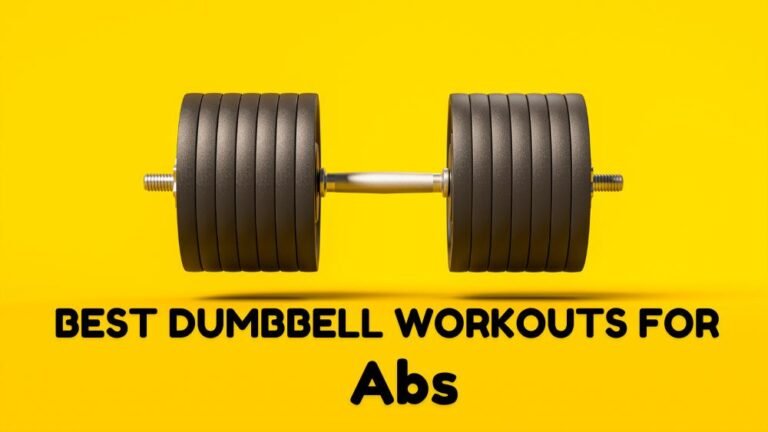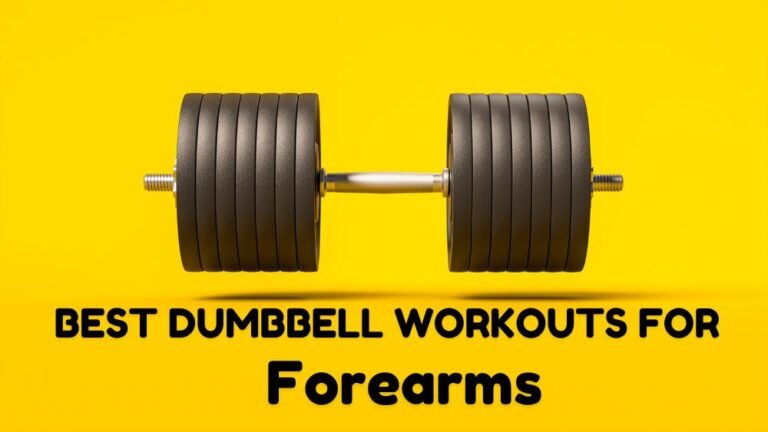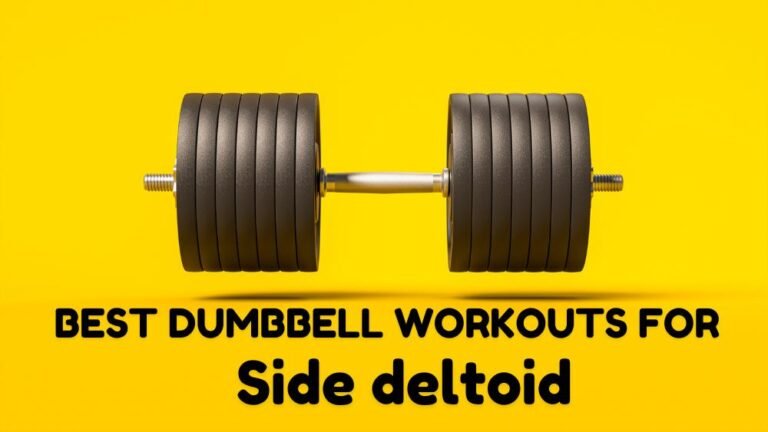9 Best Dumbbell Workouts for Adductor Strength
Strengthening the adductor muscles is essential for improving overall lower body stability, enhancing athletic performance, and preventing injuries.
While often overlooked in typical workout routines, adductor strength plays a vital role in various physical activities, from running and jumping to lateral movements and squats.
Incorporating targeted workouts using dumbbells can effectively engage these muscles, allowing individuals to achieve balanced strength and better movement mechanics.
In this guide, we’ll explore the importance of adductor strength and how dumbbell workouts can be a valuable addition to your fitness regimen.
Best Adductors exercises with dumbbell
Engaging in effective dumbbell workouts can greatly enhance the strength of your adductor muscles, which play an essential role in stabilizing your hips and improving overall leg function.
By incorporating a variety of movements that focus on lateral motion and controlled resistance, you can target these muscles effectively.
Utilizing dumbbells allows for added weight, promoting muscle growth and endurance while also encouraging proper form and alignment.
Consistently including these exercises in your fitness routine won’t only aid in building strength but also contribute to better performance in other physical activities and sports.
Dumbbell Goblet Squat
The Dumbbell Goblet Squat is an excellent exercise for targeting the adductor muscles while also engaging the quadriceps, hamstrings, and glutes. This compound movement not only builds strength but also enhances flexibility in the hip area, making it a fantastic addition to any lower-body workout routine.
By holding a dumbbell close to your chest, you can maintain an upright torso, which is essential for proper squat form and reducing the risk of injury.
Execution of the Dumbbell Goblet Squat:
- Begin by standing with your feet shoulder-width apart, holding a dumbbell vertically with both hands at chest level.
- Keep your elbows pointed down and close to your body, ensuring that the dumbbell is secure.
- Initiate the squat by bending at the hips and knees, lowering your body as if you’re sitting back into a chair.
- Keep your chest up and back straight, ensuring your knees track over your toes.
- Descend until your thighs are parallel to the ground, or as low as your mobility allows.
Dumbbell Sumo Deadlift
The Dumbbell Sumo Deadlift is a highly effective exercise for targeting the adductor muscles while also engaging the glutes, hamstrings, and lower back.
By adopting a wide stance, this variation of the traditional deadlift emphasizes the inner thigh muscles, making it an excellent choice for anyone looking to improve adductor strength and overall lower body stability.
This exercise not only enhances muscle strength but also plays a crucial role in improving athletic performance and reducing the risk of injury.
To execute the Dumbbell Sumo Deadlift effectively, follow these steps:
- Stand with your feet wider than shoulder-width apart and toes turned slightly outward, holding a dumbbell with both hands in front of you.
- Engage your core and maintain a straight back as you lower the dumbbell towards the floor by bending at the hips and knees.
- Keep the dumbbell close to your body as you descend, ensuring your knees track in line with your toes.
- Once the dumbbell reaches just above the ground, push through your heels to return to a standing position, squeezing your glutes at the top.
Dumbbell Side Lunge
The Dumbbell Side Lunge is an excellent exercise for targeting the adductor muscles, which are essential for stabilizing the hips and enhancing overall lower body strength.
This movement not only focuses on the inner thigh muscles but also engages the quadriceps, glutes, and hamstrings, making it an all-encompassing lower body workout. By incorporating dumbbells, you can increase the resistance and challenge your muscles further, leading to improved strength and muscle definition over time.
It’s particularly beneficial for athletes or individuals looking to improve their performance in sports that require lateral movements.
To execute the Dumbbell Side Lunge correctly, follow these steps:
- Stand upright with your feet shoulder-width apart, holding a dumbbell in each hand at your sides.
- Take a large step to the right with your right foot, keeping your left leg straight.
- Bend your right knee and push your hips back, lowering your body into the lunge position while keeping your chest up and core engaged.
- Make sure that your right knee stays aligned with your right foot and doesn’t extend past your toes.
- Push through your right heel to return to the starting position, bringing your left foot back to meet your right.
Dumbbell Bulgarian Split Squat
The Dumbbell Bulgarian Split Squat is an excellent exercise for targeting the adductor muscles while also engaging the quads, glutes, and hamstrings.
This unilateral movement helps to improve balance, stability, and strength in the lower body, making it a versatile addition to any workout routine.
By elevating the rear foot on a bench or platform, you increase the range of motion and intensity of the squat, which can lead to greater muscle activation in the adductors and overall leg development.
To execute the Dumbbell Bulgarian Split Squat effectively, follow these steps:
- Stand a few feet in front of a bench or elevated surface, holding a dumbbell in each hand.
- Place one foot behind you on the bench, ensuring your toes are pointed down.
- Lower your body by bending your front knee, keeping your chest up and core engaged, until your thigh is parallel to the ground.
- Press through your front heel to return to the starting position, fully extending your leg.
Dumbbell Adductor Squeeze
The Dumbbell Adductor Squeeze is an effective exercise designed to target the inner thigh muscles, also known as the adductors. This exercise not only helps to strengthen these muscles but also improves stability and overall lower body strength.
Incorporating dumbbells into the movement adds resistance, making the workout more challenging and efficient. As you perform the squeeze, you engage your core and lower body, enhancing muscle activation and promoting better form throughout your workout routine.
To execute the Dumbbell Adductor Squeeze, follow these steps:
- Begin by sitting on a bench or a sturdy surface with your feet flat on the ground.
- Hold a dumbbell vertically between your knees, gripping it lightly to maintain control.
- Engage your core and squeeze the dumbbell between your knees, focusing on contracting the inner thigh muscles.
- Hold the squeeze for a moment, feeling the tension in your adductors, then slowly release.
Dumbbell Single-Leg Deadlift
The Dumbbell Single-Leg Deadlift is an effective exercise that targets the adductor muscles while also engaging the hamstrings, glutes, and core.
This unilateral movement not only enhances strength but also improves balance and stability, making it an excellent choice for overall lower body development.
By focusing on one leg at a time, the exercise encourages greater muscle activation in the adductors, which are essential for movements involving leg adduction and stabilization during various physical activities.
To execute the Dumbbell Single-Leg Deadlift, follow these steps:
- Stand upright with a dumbbell in one hand, keeping your feet hip-width apart.
- Shift your weight onto the leg opposite the side holding the dumbbell.
- Slightly bend the knee of the standing leg and hinge at the hips to lower the dumbbell towards the ground, extending the free leg straight behind you for balance.
- Keep your back straight and core engaged as you lower the dumbbell until you feel a stretch in the hamstring of the standing leg.
- Return to the starting position by driving through the heel of the standing leg and bringing your torso back to an upright position.
Dumbbell Plie Squat
The Dumbbell Plie Squat is an excellent exercise for targeting the adductor muscles, which are essential for inner thigh strength and stability. This squat variation not only engages the adductors but also activates the quadriceps, glutes, and hamstrings, making it a thorough lower body workout.
The unique positioning of the feet in a wider stance allows for greater emphasis on the inner thigh muscles, enhancing overall lower body strength and flexibility.
To execute the Dumbbell Plie Squat effectively, follow these steps:
- Stand with your feet wider than shoulder-width apart, toes pointed slightly outward.
- Hold a dumbbell with both hands, letting it hang between your legs.
- Engage your core and keep your chest lifted as you lower your body into a squat, bending at the knees and pushing your hips back.
- Descend until your thighs are parallel to the ground or as low as you can comfortably go.
- Press through your heels to return to the starting position, squeezing your glutes at the top.
Dumbbell Curtsy Lunge
The Dumbbell Curtsy Lunge is an exceptional exercise for targeting the adductor muscles, which are essential for stabilizing the hips and maintaining overall lower body strength.
This movement mimics the action of curtsying, which involves a unique lateral shift that effectively engages the inner thighs. By incorporating dumbbells, you not only increase the resistance but also enhance the challenge for your balance and coordination.
As a result, this exercise not only strengthens the adductors but also promotes functional movement patterns that are beneficial in daily activities and athletic performance.
To execute the Dumbbell Curtsy Lunge correctly, follow these steps:
- Stand upright with a dumbbell in each hand, arms by your sides.
- With your right leg, step back and to the left, crossing it behind your left leg into a curtsy position.
- Lower your body until your front thigh is parallel to the ground, keeping your chest up and core engaged.
- Push through your left heel to return to the starting position, bringing your right leg back to the front.
Dumbbell Standing Adduction
Dumbbell Standing Adduction is an effective exercise aimed at strengthening the adductor muscles, which are essential for stabilizing the hips and improving overall lower body performance.
This exercise not only targets the inner thigh muscles but also engages the core, promoting better balance and coordination.
Incorporating this move into your workout routine can help enhance athletic performance, improve posture, and reduce the risk of injuries related to hip and leg movements.
To execute the Dumbbell Standing Adduction correctly, follow these steps:
- Stand upright with your feet hip-width apart, holding a dumbbell in your right hand.
- Shift your weight onto your left leg, keeping it slightly bent for stability.
- Raise your right leg out to the side while keeping it straight and the toe pointed forward, ensuring the movement is controlled.
- Slowly bring your right leg back down to the starting position, maintaining control throughout the motion.
Anatomy of the Adductors muscle
The adductor muscles, located in the inner thigh, play an important role in stabilizing the pelvis and facilitating movements such as leg adduction, which involves bringing the legs together.
This group consists of five primary muscles: the adductor longus, adductor brevis, adductor magnus, pectineus, and gracilis. Together, they support activities ranging from walking and running to squatting and lateral movements.
Strengthening the adductors is essential for enhancing athletic performance and preventing injuries, particularly in sports that require quick lateral shifts or changes in direction.
A well-balanced fitness routine that includes targeted dumbbell workouts can effectively improve the strength and endurance of these muscles, contributing to overall lower body stability and functionality.
Benefits of dumbbell Adductors exercises
Dumbbell exercises targeting the adductor muscles provide numerous benefits, including enhanced muscle mass and functional strength. By incorporating unilateral movements, these workouts engage each leg independently, helping to identify and rectify any strength imbalances, which ultimately contributes to a more balanced lower body.
Additionally, the stabilization required during dumbbell training promotes better coordination, essential for athletic performance and overall movement efficiency.
Moreover, strengthening the adductors with dumbbells can lead to improved joint stability and reduced injury risk, particularly in activities that require lateral movement. As these exercises activate multiple muscle fibers, they not only build strength but also enhance flexibility and range of motion in the hips, supporting overall mobility and athleticism.
Important training variables to consider
When planning your adductor workouts, it’s vital to take into account variables like exercise selection, volume, intensity, and rest periods to maximize your results. Focusing on these key factors can help you build strength and prevent injury.
Here’s what to reflect on:
- Exercise Selection: Choose a variety of exercises that target the adductors from different angles. Incorporate moves like dumbbell side lunges and sumo squats to engage these muscles effectively.
- Volume: Determine how many sets and repetitions you’ll perform. Generally, 3-4 sets of 8-12 reps can provide a solid balance of strength and hypertrophy.
- Intensity: Adjust the weight of your dumbbells to challenge yourself while maintaining good form. It’s important to push your limits but not to the point of compromise.
- Rest Periods: Allow adequate recovery between sets. Typically, resting for 30-90 seconds can help you maintain performance without sacrificing strength gains.
Sample Adductors workout with dumbbell
When it comes to strengthening the adductors, incorporating dumbbells into your workout routine can be highly effective. Adductors are the muscles located in the inner thigh responsible for bringing the legs together and stabilizing your movements. A well-designed workout program that focuses on these muscles not only enhances lower body strength but also improves overall balance and athletic performance. Below is a sample adductor workout utilizing dumbbells that targets these essential muscles.
| Exercise | Sets | Reps | Rest |
|---|---|---|---|
| Dumbbell Side Lunges | 3 | 10-12 | 60s |
| Dumbbell Sumo Squats | 3 | 12-15 | 60s |
| Dumbbell Adductor Raises | 3 | 10-12 | 60s |
| Dumbbell Side Leg Raises | 3 | 12-15 | 60s |
| Dumbbell Cossack Squats | 3 | 10-12 | 60s |
This workout can be performed 1-2 times a week to effectively target and strengthen your adductor muscles. Remember to maintain proper form and control throughout each exercise to maximize benefits and minimize the risk of injury.
Questions
How Often Should I Train My Adductors With Dumbbells?
You should train your adductors two to three times a week. This frequency allows for adequate recovery while promoting strength gains. Just remember to balance your routine with other muscle groups for overall stability.
Can Beginners Perform Dumbbell Adductor Exercises Safely?
Yes, you can perform dumbbell adductor exercises safely as a beginner. Just start with lighter weights, focus on your form, and gradually increase intensity. Listen to your body, and don’t push yourself too hard initially.
What Is the Recommended Weight for Dumbbell Adductor Workouts?
When choosing a weight for dumbbell adductor workouts, start light to focus on form and control. Gradually increase weight as you gain strength and confidence, aiming for a challenge without compromising your technique.
Are There Any Common Mistakes to Avoid During Adductor Exercises?
When doing adductor exercises, avoid using too much weight, sacrificing form, or rushing through reps. Focus on controlled movements, proper alignment, and breathing. These mistakes can lead to injury and reduce the effectiveness of your workout.
How Can I Track My Progress in Adductor Strength Training?
To track your progress in adductor strength training, keep a workout journal. Note the weights you lift, repetitions, and how you feel. Regularly reassess your performance to see improvements and adjust your routine accordingly.
Conclusion
Incorporating these 12 best dumbbell workouts for adductor strength into your routine can greatly enhance your lower body stability and overall performance.
By targeting the inner thigh muscles, you’ll improve coordination and reduce your risk of injuries.
Remember to focus on proper form and gradually increase weights as you progress.
With consistency and dedication, you’ll notice stronger, more balanced legs in no time.
So grab those dumbbells and start building your adductor strength today!

